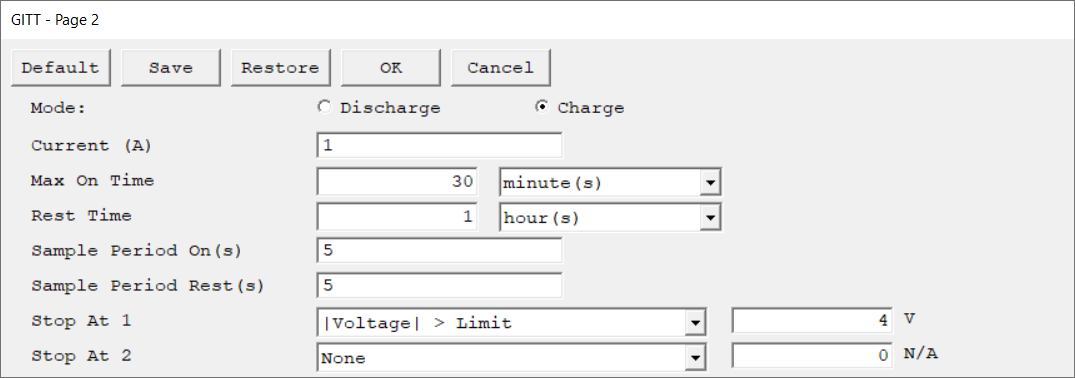Description
Second setup page of the Galvanostatic Intermittent Titration Technique experiment. Press OK to continue or Cancel to go back to the first setup page.
Parameter |
Description |
Units |
|||||||||||||||||||||||||||||||||||
|---|---|---|---|---|---|---|---|---|---|---|---|---|---|---|---|---|---|---|---|---|---|---|---|---|---|---|---|---|---|---|---|---|---|---|---|---|---|
Set the polarity of the current pulses being applied: •Charge Electric current flows out of the cell through the working lead (green) and into the cell through the counter lead (red). When Positive is selected for the Working Lead in a two-terminal cell, electrons flow out from the positive terminal and into the negative terminal. •Discharge Electric current flows out of the cell through the counter lead (red) and into the cell through the working lead (green). When Positive is selected for the Working Lead in a two-terminal cell, electrons flow out from the negative terminal and into the positive terminal. |
|
||||||||||||||||||||||||||||||||||||
Specify the magnitude of the current pulse. |
amperes (A) |
||||||||||||||||||||||||||||||||||||
Duration of each current pulse to be applied. A typical value is 10–15 minutes. |
seconds (s), minutes (min), hours (hr), days (d) |
||||||||||||||||||||||||||||||||||||
The duration of each rest phase during the experiment. A typical value is 10–15 minutes. |
seconds (s), minutes (min), hours (hr), days (d) |
||||||||||||||||||||||||||||||||||||
The spacing between data points during the pulse signals. |
seconds (s) |
||||||||||||||||||||||||||||||||||||
The spacing between data points during the rest periods. |
seconds (s) |
||||||||||||||||||||||||||||||||||||
Specify various limits to an experiment. Choose a limit criterion from the drop-down list and enter a limit value. The unit automatically updates according to the criterion. The limit, if met, causes the experiment to skip to the next step, or stop if there is no subsequent step.
Most experiments have Stop At 1 and Stop At 2 criteria. These parameters are treated equally, and if both are used, they are both tested on every raw data point. If either limit is reached, the experiment skips to the next step or stops entirely.
|
|
||||||||||||||||||||||||||||||||||||
|

